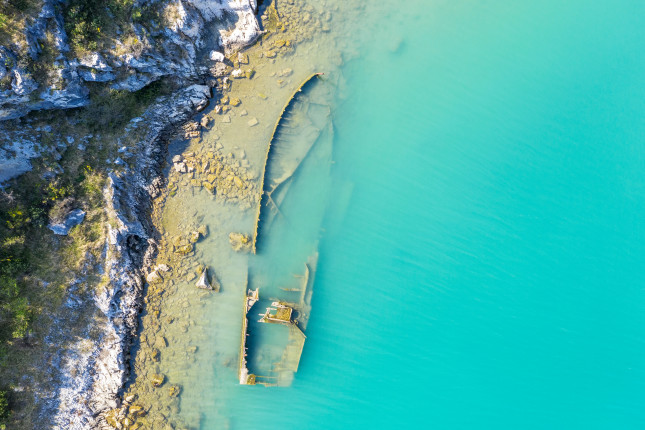By Wim Zwijnenburg
This summer, climate-induced heat waves ignited landmines and unexploded ordnance buried in the soils around the Middle East, killing people and causing wildfires. Warmer waters are speeding up erosion of sunken battleships laden with degrading munitions. A melting ice sheet on Greenland has exposed thousands of barrels of toxic waste at abandoned U.S. military bases.
Remains of War
This is what happens when a ghost from the past comes back to haunt us. The hazardous remnants of war are re-emerging. They include unexploded ordnance (UXO) and other vestiges of war. These military hazards that climate change can “wake up” or expose include landmines, ammunition, toxic waste, chemical weapons, and nuclear materials. Many types of unexploded ordnance in the ground and seas are the legacy of more than 120 years of wars and armed conflicts. Sunken battleships and military freighters from both world wars and regional conflicts rust away on the bottom of the ocean. Decades of wars have created explosive and toxic legacies in our seas and soils that threaten lives and ecosystems.
Effects of Climate Change
Mixing the remains of war with climate change is a recipe for disaster. Degrading munitions left in the soil or water can become unstable over time as the chemicals change, influenced by environmental conditions. Millions of unexploded munitions and mines in the soil degrade more rapidly in the heat, which can result in uncontrolled explosions. Climate-linked wildfires in Ukraine and Iraq resulted in landmines cooking up and exploding, sparking massive fires. On other occasions, Turkey’s and Iran’s military activities against Kurdish militants resulted in large fires spreading in areas with massive UXO contamination. In 2019, a year with an extraordinarily high number of wildfires, firefighters were killed by old mines and other explosive remnants of war. Rapidly rising temperatures, extreme weather events, and melting icecaps bring out a range of new challenges that we need to fully understand to prevent human suffering and an even more rapid decline of ecosystems, Yet the magnitude of this problem is unclear.
Scorching Heat and Rising Tides
The scorching summer heat in the Middle East exacerbated by climate change has put the hazards associated with munitions back on the agenda. After some mysterious explosions at military bases in Iraq in 2019 caused unrest, investigations revealed that increased heat affected unsafely stored ammunition, destabilizing the components, and exploding. But most of those munitions were relatively new. An older enemy soon emerged from under the grass: Millions of unexploded munitions and mines in the soil were degrading more rapidly from the heat. Over the last years, Iraqi Kurdistan has been witnessing a massive increase of wildfires. New information indicated that landmines blew up because of the increased heat from widespread forest fires. An estimated 26,000 hectares of heavy contaminated land from the Iran-Iraq War and Gulf Wars still needs clearing. Similar problems occurred on the heavily contaminated border between Lebanon and Israel, where decaying mines exploded from the summer heat. Apart from the fires, heavy rainfall and related extreme weather events pose growing risks that result in flooding and soil change. As a result, UXOs buried deep in the soil resurface and get flushed downstream, ending up in unmarked areas, posing again an explosive hazard for civilians. This was the case in Bosnia Herzegovina, the wider Balkan area, and in Western Sahara. Similar problems cropped up this summer in the border between Syria and Lebanon as well as in Yemen. In Laos, the UNDP is already anticipating these climate-linked security risks in UXO-clearance operations.
Photo-Source: newsecuritybeat.org
Photo Credit: An aerial view of the sunken German ship Fritz from World War II in the bay of Salamustica in Rasa Bay, Istria, Croatia, courtesy of burnel1, Shutterstock.com.
Biography of a Bomb
Dear editors, Biography of a bomb is aimed at highlighting the danger caused by unexploded bombs. Moreover, the most important aspect is that we work completely non profit, raising awerness about this topic is what drives us. We apologize if we make use of pictures in yours articles, but we need them to put a context in how findings are done. We will (and we always do) cite source and author of the picture. We thank you for your comprehension.





